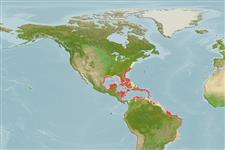Common names from other countries
Environment: milieu / climate zone / depth range / distribution range
Ecologie
marien rifbewoner; diepte 3 - 70 m (Ref. 13121), usually 5 - 20 m (Ref. 13121). Tropical; 41°N - 29°S, 100°W - 28°W (Ref. 55200)
Western Atlantic: Massachusetts, USA to Santa Catarina, Brazil (Ref. 57756), including the Gulf of Mexico and Caribbean Sea. Eastern Central Atlantic: St. Paul's Rocks (Ref. 13121).
Lengte bij maturiteit / Grootte / Gewicht / Leeftijd
Maturity: Lm 12.4 range ? - ? cm
Max length : 16.0 cm TL mannelijk / geslacht onbekend; (Ref. 9710)
Dorsale stekels (totaal) : 12; Dorsale zachte stralen (totaal) : 19 - 21; Anale stekels: 3; Anale zachte stralen: 16 - 17. With two broad black bars on side of body and a third bar basally in soft portion of dorsal fin which extends onto caudal peduncle; broad black submarginal bands in the median fins; pelvic fins black except for the spine (Ref. 13442).
Maximum depth from Ref. 126840. Inhabit coral reefs. Occur singly or in pairs. Feed on polychaete worms, coral polyps, crustaceans and mollusk eggs. Oviparous (Ref. 205), monogamous (Ref. 52884). Form pairs during breeding (Ref. 205). Adults may form plankton-feeding aggregations of up to 20 individuals, and occasionally clean other reef fishes which join the group, such as grunts, parrotfishes and surgeon fishes. (Ref: 40093). Generally common (Ref. 9710).
Levenscyclus en paargedrag
Maturities | Voortplanting | Spawnings | Egg(s) | Fecundities | Larven
Distinct pairing (Ref. 205). Monogamous mating is observed as both obligate and social (Ref. 52884).
Allen, G.R., 1985. Butterfly and angelfishes of the world. Vol. 2. 3rd edit. in English. Mergus Publishers, Melle, Germany. (Ref. 4858)
Status op de Rode Lijst van het IUCN (Ref. 130435)
CITES (Ref. 128078)
Not Evaluated
Gevaar voor de mens
Harmless
Gebruik door de mens
Visserij: commercieel; Aquarium: Commercieel
Tools
Speciale rapporten
Download XML
Internetbronnen
Estimates based on models
Preferred temperature (Ref.
115969): 25 - 28, mean 27.2 (based on 158 cells).
Fylogenetische diversiteitsindex (Ref.
82804): PD
50 = 0.5000 [Uniqueness, from 0.5 = low to 2.0 = high].
Bayesian length-weight: a=0.02239 (0.01442 - 0.03475), b=3.02 (2.89 - 3.15), in cm Total Length, based on LWR estimates for this species & Genus-body shape (Ref.
93245).
Trofisch niveau (Ref.
69278): 3.5 ±0.2 se; based on diet studies.
Weerstandsvermogen (Ref.
120179): Hoog, minimale populatieverdubbelingstijd minder dan 15 maanden (Preliminary K or Fecundity.).
Fishing Vulnerability (Ref.
59153): Low vulnerability (10 of 100).
